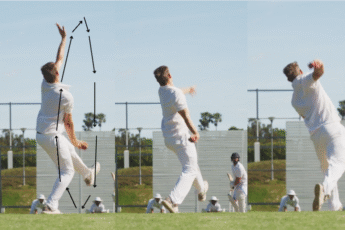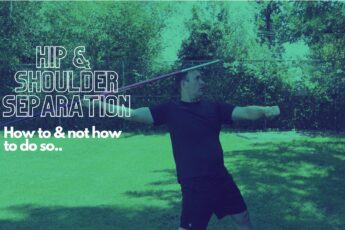Last Updated on February 4, 2025 by admin
Mastering the art of javelin throwing requires so much more than just raw strength. It demands a combination of precision, agility, and explosive power. In this article, we delve into the essential exercises that can take your javelin throwing skills to the next level.
By far, understand that javelin is a technical event much like golf. It actually uses the opposing recruitment of golf. It’s possible that an elite golfer may understand what an elite javelin thrower is doing and vice versa when it comes to the hips.
From explosive plyometric drills to targeted strength training, mastering these 10 essential exercises will not only enhance your throwing distance but also improve your overall athleticism. Whether you’re a seasoned javelin thrower looking to refine your technique or a newbie seeking to excel in this challenging sport, these exercises are tailored to elevate your performance.
So, get ready to unleash your full potential on the field as we break down the key exercises that will sculpt you into a javelin throwing powerhouse. By incorporating these exercises into your training regimen, you’ll be on track to dominate the competition and surpass your personal bests in no time.
Understanding the javelin throw
The javelin throw is a track and field event where athletes aim to throw a spear as far as possible within a designated area. It requires a unique blend of strength, speed, and technique. The thrower must generate maximal force and transfer it efficiently through the entire body to propel the javelin to its farthest distance. The throwing technique involves a complex series of movements, including an explosive run-up, a coordinated approach to the throwing line, and a powerful release of the javelin.
Mastering the javelin throw demands a deep understanding of biomechanics and a comprehensive training regimen that encompasses strength, power, speed, flexibility, and mental focus. To excel in this challenging event, athletes must commit to a disciplined training program that hones their physical and mental capabilities while minimizing the risk of injury. Now, let’s explore the essential components of physical conditioning for javelin throwers and the key exercises that can elevate your performance to new heights.
—
Importance of physical conditioning for javelin throwers
Physical conditioning forms the foundation of success for javelin throwers. It involves developing strength, power, speed, agility, and endurance to execute the intricate movements required for a powerful javelin throw. By improving overall physical fitness and specific muscle groups used in the throw, athletes can enhance their throwing distance and technique while reducing the risk of injury. A well-rounded physical conditioning program also contributes to improved performance in other track and field events, making it an essential aspect of an athlete’s training regimen.
To excel in the javelin throw, athletes must prioritize strength and power development in the lower body, core stability and rotational strength, shoulder and arm strength, as well as explosive speed and agility. A comprehensive conditioning program should address these key areas through targeted exercises that replicate the demands of the javelin throw. Now, let’s delve into the specific muscle groups involved in javelin throwing and explore the essential exercises that can elevate your performance on the field.
—
Key muscle groups for javelin throwing
The javelin throw requires coordinated activation of various muscle groups to generate the explosive power and precise movements necessary for a successful throw. Key muscle groups involved in the javelin throw include the glutes, quadriceps, hamstrings, core muscles, shoulder girdle, and arm muscles.
Notice how there isn’t much to do about arms? most of the power comes from supportive muscles especially on the vertical plane. Think of how you would hold an Olympic bar across your collarbones in the “catch”. This is the strength we want. The kind where you won’t collapse under pressure when delivering the throw.
Developing strength, power, and endurance in these muscle groups is essential for achieving peak performance in the javelin throw. Targeted exercises that focus on strengthening and conditioning these muscle groups can significantly improve throwing distance, technique, and overall athleticism. Now, let’s explore the 10 essential exercises tailored to enhance the capabilities of javelin throwers and propel them towards peak performance.
—
10 essential exercises for javelin throwers
1. Plyometric Box Jumps: (advanced only) Plyometric exercises are crucial for developing explosive power in the lower body. Box jumps, in particular, help javelin throwers improve their ability to generate force from the legs and transfer it efficiently through the entire body. Perform multiple sets of box jumps with varying heights to challenge your explosive strength and coordination.
2. Medicine Ball Rotational Throws: Rotational throws with a medicine ball mimic the rotational movement pattern of the javelin throw. This exercise focuses on building core stability, rotational power, and coordination, which are essential for generating speed and force during the throw.
3. Barbell Squats: Squats are fundamental for developing lower body strength and power. Barbell squats target the quadriceps, glutes, and hamstrings, enhancing the force-generating capacity of the lower body to propel the javelin with greater speed and distance.
4. Overhead Press: The overhead press targets the shoulder girdle muscles and arms, which are crucial for the javelin release. Strengthening these muscles improves the ability to generate speed and power during the throwing motion.
5. Single-Leg Romanian Deadlifts: This exercise hones balance, stability, and strength in the hamstrings and glutes, contributing to better control and force production during the approach and release phases of the javelin throw.
6. Kettlebell Swings: Kettlebell swings engage the entire posterior chain, including the glutes and hamstrings, to develop explosive hip extension and power transfer, essential for a forceful javelin throw.
7. Sprint Intervals: Speed and acceleration are crucial for the javelin approach. Sprint intervals improve running speed, acceleration, and overall anaerobic fitness, enhancing the explosive power needed during the run-up.
8. Pull-Ups: Strengthening the back and arm muscles through pull-ups contributes to a powerful and coordinated arm action during the javelin throw, improving the force generated during the release.
9. Russian Twists: This core-strengthening exercise enhances rotational power and stability, essential for the coordinated rotational movements involved in the javelin throw.
10. Javelin Throw Simulation Drills: Incorporating specific javelin throw simulation drills into training helps athletes refine their technique, timing, and coordination while replicating the demands of the actual throw.
11. Bonus: Pullovers: A javelin classic, probably pretty important to be good at them.
By integrating these 10 essential exercises into your training regimen, you’ll develop the physical attributes necessary to excel in the javelin throw. Now, let’s explore the role of flexibility and mobility in javelin throwing and understand how nutrition, recovery, and mental preparation contribute to peak performance in this demanding sport.
—
The role of flexibility and mobility in javelin throwing
Flexibility and mobility are often overlooked aspects of javelin throwing, yet they play a crucial role in optimizing performance and reducing the risk of injury. A comprehensive stretching and mobility routine helps javelin throwers achieve an optimal range of motion in key joints and muscle groups involved in the throw. It also contributes to improved coordination, fluidity of movement, and overall athleticism.
Javelin throwers should prioritize flexibility exercises that target the shoulders, hips, hamstrings, and thoracic spine, as these areas are heavily involved in the throw’s rotational and explosive movements. Incorporating dynamic stretching, mobility drills, and foam rolling into the warm-up and cool-down routines can enhance joint flexibility, muscle elasticity, and overall movement quality. Now, let’s shift our focus to the crucial aspects of nutrition and recovery that support the demanding physical demands of javelin throwing.
—
Nutrition and recovery for javelin athletes
Optimal nutrition and effective recovery strategies are essential for supporting the rigorous training and competition demands placed on javelin athletes. A well-balanced diet that provides adequate energy, macronutrients, and micronutrients is crucial for fueling training sessions, optimizing performance, and supporting recovery. Javelin throwers should prioritize a nutrition plan that emphasizes lean proteins, complex carbohydrates, healthy fats, and ample hydration to meet their energy needs and promote muscle recovery.
In addition to nutrition, adequate rest, sleep, and recovery practices are vital for allowing the body to adapt to training stress and optimize performance. Implementing strategies such as active recovery sessions, massage therapy, and proper sleep hygiene can enhance recovery between training sessions and competitions, reducing the risk of overuse injuries and promoting long-term athletic development. Now, let’s explore the mental preparation and focus required for peak performance in the javelin throw.
—
Mental preparation and focus for peak performance
The mental aspect of javelin throwing is just as critical as the physical component. Developing mental resilience, focus, and visualization skills can significantly impact an athlete’s performance and confidence during training and competition. Javelin throwers must cultivate a strong mental game that enables them to stay composed under pressure, maintain focus during the approach and release, and visualize successful throws with unwavering confidence.
Incorporating mental training techniques such as visualization, positive self-talk, and mindfulness meditation can help javelin athletes refine their mental approach and develop the mental toughness required to excel in high-pressure situations. Cultivating a strong sense of mental preparedness and focus can be the differentiating factor between a good throw and a great one. Now, let’s shift our focus to perfecting the javelin throw technique and understanding the importance of injury prevention and management for javelin throwers.
—
Perfecting the javelin throw technique
Mastering the javelin throw technique requires a meticulous approach to refining each phase of the throw, from the run-up and approach to the release and follow-through. Coaches and athletes should prioritize technical drills, video analysis, and feedback mechanisms to identify and address biomechanical inefficiencies, timing issues, and coordination challenges in the throw.
The standing javelin throw is by far the most important part of training and could comprise up to half of a practice. Jan Zelezny spent a great deal of training working on standing throws.
Emphasizing proper body positioning, arm action, and footwork during the approach and release is crucial for optimizing the javelin’s trajectory and maximizing throwing distance. Through consistent technical drills and focused practice, athletes can refine their throwing technique and develop a more efficient and powerful throwing motion. Now, let’s explore the critical strategies for injury prevention and management in the context of javelin throwing.
—
Injury prevention and management for javelin throwers
Injury prevention is a paramount concern for javelin throwers, given the high-impact nature of the event and the specific demands it places on the body. Athletes and coaches should prioritize prehabilitation exercises, proper warm-up routines, and strength training to fortify vulnerable areas and reduce the risk of common injuries such as shoulder strains, lower back issues, and overuse injuries.
In the event of an injury, prompt and comprehensive management is essential to facilitate optimal recovery and minimize the impact on an athlete’s training and competitive schedule. Javelin throwers should seek professional medical evaluation, rehabilitation programs, and gradual return-to-play protocols to ensure a safe and effective recovery from injuries. By prioritizing injury prevention and proactive management, athletes can sustain long-term participation and success in the javelin throw. Now, let’s conclude our exploration of mastering the javelin throw with key takeaways and next steps for athletes seeking to elevate their performance.
—
Conclusion and next steps for mastering the javelin throw
Mastering the javelin throw demands a holistic approach that encompasses physical conditioning, technical proficiency, mental resilience, and injury management. By incorporating the essential exercises, prioritizing flexibility and mobility, optimizing nutrition and recovery, and refining the mental aspect of performance, javelin throwers can elevate their capabilities and excel in this challenging sport.
Aspiring javelin athletes should commit to a well-structured training program that integrates the key components discussed in this article. Seeking guidance from experienced coaches, sports medicine professionals, and strength and conditioning experts can further enhance an athlete’s development and performance in the javelin throw.
With dedication, perseverance, and a comprehensive approach to training, athletes can hone their javelin throwing skills and unleash their full potential on the field. Mastering the javelin throw is a rewarding journey that requires discipline, passion, and a relentless pursuit of excellence. By embracing the essential exercises and principles outlined in this article, athletes can embark on a path towards peak performance and achievement in the thrilling world of javelin throwing.
TJ





